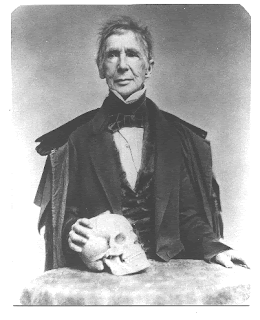 |
| Dr. John Collins Warren, circa 1850 |
When giving tours of the Gibson House, I always share details of Rosamond Warren Gibson’s (1846–1934) family background, noting that within her family were a number of prominent doctors. Among them were her own father, Jonathan Mason Warren; her great-granduncle, Major General Joseph Warren, who was killed in action at the Battle of Bunker Hill; and her paternal grandfather, John Collins Warren.
Dr.
John Collins Warren is particularly noteworthy because he is credited with
performing the earliest recorded operation using ether as a general anesthetic,
in 1846. And, fortunately, he wrote an account of this experiment only a year
after the procedure, which was published in 1848.
The
potential for ether as a surgical anesthetic had been brought to Dr. Warren’s
attention by a Boston dentist, Dr. W.T.G. Morton, who had previously
experimented with ether’s pain-relieving capabilities during dental procedures.
In
his account of the ether experiment, Dr. Warren noted that “the general
properties of ether have been known for more than a century, and the effect of
its inhalation in producing exhilaration and insensibility has been known for
many years.” Prior to ether’s application as an anesthetic, surgery was a
horrendous and painful ordeal.
Dr.
Warren captured how sympathetically surgeons felt toward their patients’
experience of pain when he wrote, “What surgeon is there, who has not felt,
while witnessing the distress of long painful operations, a sinking of the
heart, to which no habit could render him insensible! What surgeon has not at
these times been inspired with a wish, to find some means of lessening the
sufferings he was obliged to inflict!”
Thus,
when Dr. Morton called upon Dr. Warren at the Massachusetts General Hospital
(MGH) in 1846 to propose his ether experiment, Dr. Warren was intrigued and,
after reassurances from Dr. Morton, consented to using ether at his next
surgery.
The
opportunity came shortly thereafter when Dr. Warren was scheduled to operate on
a young man in his early twenties. The patient had a tumor on the left side of
his neck, which Dr. Warren planned to remove. After making his own
preparations, Dr. Warren allowed the dentist to administer the ether. “The
patient was then made to inhale a fluid from a tube connected with a glass
globe. After four or five minutes he appeared to be asleep, and was thought by
Dr. Morton to be in a condition for the operation.”
 |
| First Operation Under Ether, Robert C. Hinckley, 1894 |
At
first Dr. Warren doubted the success of the experiment, because at various
points in the operation, the patient “move[d] his limbs, cr[ied] out, and
utter[ed] extraordinary expressions.” Yet when Dr. Warren consulted with the
patient afterward, the young man explained that while he had been aware of the
operation, he had felt no pain.
Thrilled
by the success of this initial trial, other surgeons at MGH started to
administer ether in their own operations, with similar results. News of this successful
anesthetic spread. As Dr. Warren wrote, “An immense number of trials of its
influence [were subsequently] made in various parts of the world, with a
success perhaps as uniform as that of any article employed in medicine or
surgery.”
The
United States Army took notice, too. During the Mexican-American war (1846–1848),
medical officers administered ether to wounded soldiers to perform amputations
and other procedures. By the time of the Civil War (1861–1865), however,
chloroform had displaced ether as the primary anesthetic used by the military because
of its fast-acting nature.
While
ether and chloroform are no longer used in surgery today, these two drugs were
important contributions to the field of medicine and ended centuries of
painful, torturous surgery.
By
Timothy Spezia, museum guide
Note
from the museum:
This is Timothy Spezia’s final blog post, as he graduates from Boston
University and moves on to a full-time position in the history field. We wish
Tim all the best, and thank him for his excellent work as a museum guide and
for all the wonderful posts he has written for the blog!
Image Sources:
Dr. John Collins Warren, https://en.wikipedia.org/wiki/John_Collins_Warren
Ether painting, http://www.woodlibrarymuseum.org/history-of-anesthesia/
Sources:
“Ether
and Chloroform.” History Channel website.
Accessed April 20, 2016. http:// http://www.history.com/topics/ether-and-chloroform.
Warren,
John C., Etherization with Surgical
Remarks. Boston: William D. Ticknor & Company, 1848, accessed via www.collections.nlm.nih.gov,
April 20, 2016.

No comments:
Post a Comment